Clear Skies
Clear Skies in Idaho
Highlights of Clear Skies in Idaho

- Idaho sources would reduce emissions of NOx by 24% in 2020 due to Clear Skies. There will be no emissions of SO2 and mercury in 2020.
- The health benefits in the West would total $8.6 billion annually ($1.6 billion under the alternative estimate) and include approximately 1,100 fewer premature deaths (600 under the alternative estimate) and 2,500 fewer hospitalizations/emergency room visits each year.
- In addition, Western states would continue to enjoy good visibility and the other benefits of a clean environment even in the face of increasing demand for electricity.
- Clear Skies does not significantly impact electricity prices. With or without Clear Skies, electricity prices in the electricity supply region that includes Idaho are expected to remain below 2000 national average prices.
Note: There are no coal-burning power plants in Idaho.
Note: For the purposes of this analysis, the West includes all states that would be affected by the Zone 2 cap for NOx under Clear Skies. These states are WA, OR, CA, UT, AZ, ID, MT, WY, CO, NM, TX, OK, KS, NE, ND, and SD.
Clear Skies: An Innovative Approach to Improving Human Health and the Environment
Why Clear Skies?
- Air quality has improved, but serious concerns persist
- Idaho's citizens suffer ill effects from air pollution, including asthma attacks and premature death
- Electricity generation sector remains a major emissions source
- Very cost-effective to control the power sector, relative to other sources
- Sources are concerned about upcoming complex and burdensome regulations
Advantages of the Clear Skies Approach
- Guarantees significant nationwide emissions reductions -- beginning years before full implementation
- Idaho sources would substantially reduce emissions of SO2, NOx and mercury
- Delivers dramatic progress towards achievement of critical health and environmental goals
- Uses proven, market-based flexible approach with incentives for innovation
- Recognizes environmental needs as well as industry constraints, allowing industry to better manage its operations and finances while lowering risks to the public
- Sources are projected to install pollution controls to enable continued reliance on coal
- Increases certainty across the board for industry, regulators, and consumers
Under Current Clean Air Act Power Plants Would Face a Complex Set of Requirements
For a larger image, click here.
Clear Skies Sets a Firm Timeline for Emission Reductions
| The existing Title IV SO2 cap-and-trade program provides an incentive and a mechanism to begin reductions upon enactment of Clear Skies years before regulatory action under the current Act. |
2004: The NOx SIP call (summertime NOx cap in 19 Eastern States + D.C.)
2008: Clear Skies NOx Phase I (2.1 million ton annual cap assigned to two Zones with trading programs)
2010:
- Clear Skies Hg Phase I (26 ton annual cap with a national trading program)
- SO2 Phase I (4.5 million ton annual cap with a national trading program)
2018:
- Clear Skies NOx Phase II (1.7 million ton annual cap assigned to two Zones with trading programs)
- Clear Skies Hg Phase II (15 ton annual cap with a national trading program)
- Clear Skies SO2 Phase II (3.0 million ton annual cap with a national trading program)
Clear Skies Builds Upon the Work of the WRAP
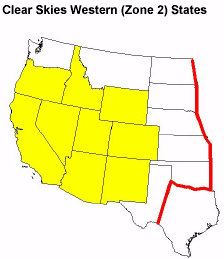
- Clear Skies is designed to support the WRAP goals and process;
in addition to a national constraint on SO2, the bill ensures
that the WRAP's emissions reduction goal for nine states is achieved:
- If for any reason the regional reduction goal set by the
WRAP for 2018 (271,000 tons for the power sector) is not achieved,
a separate WRAP cap-and-trade program is triggered to ensure
that the regional reductions are preserved.
- This special cap-and-trade program is based on the framework established in the WRAP process.
- This special cap can also be triggered by 2013 if States determine there is sufficient evidence that the target will not be met by 2018.
- If for any reason the regional reduction goal set by the
WRAP for 2018 (271,000 tons for the power sector) is not achieved,
a separate WRAP cap-and-trade program is triggered to ensure
that the regional reductions are preserved.
Note: Yellow states are states involved in the WRAP voluntary emissions reduction program.
The West Faces Unique Challenges
- Environmental effects of power plant emissions - including visibility
impairment and acid deposition - are broadly distributed
- Increasing ground-level ozone concentrations in national parks
- Particle-related haze in national parks and wilderness areas
- Nitrogen deposition in high elevation ecosystems (e.g., Colorado Front Range)
- Brown clouds in major cities
- Few western non-attainment areas are due to stationary source emissions

As the West Grows, Clear Skies Protects Human Health and the Environment
The West Will Continue to Grow...

- Population is projected to grow more than 20% from current levels by 2020
- Electricity demand is expected to grow more than the national
average
- More than 10% over national average in the Pacific States
- More than 30% over national average in the Mountain States
...While the Environment Is Protected

- Clear Skies would protect air quality by lowering or halting
increases in air emissions throughout the West from today's levels:
- Prevent degradation of visibility in parks.
- Help counties remain in attainment with health-based air quality standards, reducing the burden on state and local governments.
- Ensure nitrogen deposition does not increase and reduce mercury deposition.
Emissions in Idaho under Clear Skies
|
Emissions in Idaho (2020) compared to the base case:
There are no coal-fired power plants in Idaho |
Emissions: Existing Clean Air Act Regulations (base case*) vs. Clear Skies in Idaho in 2010 and 2020
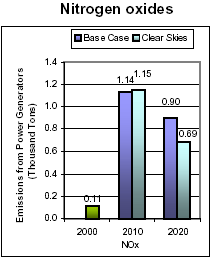
Note: The base case using IPM includes Title IV, the NOx SIP Call, NSR settlements, and state-specific caps in CT, MA, MO, NC, NH, TX, and WI. It does not include mercury MACT in 2007 or any other potential future regulations to implement the current ambient air quality standards or other part of the Clean Air Act. Base case emissions in 2020 will likely be lower due to state and federal regulatory actions that have not yet been promulgated.
SO2 and NOx Emissions Reductions under Clear Skies
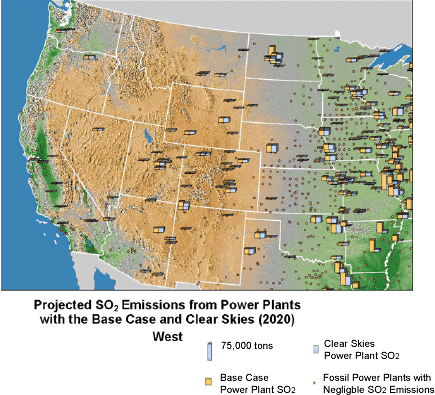
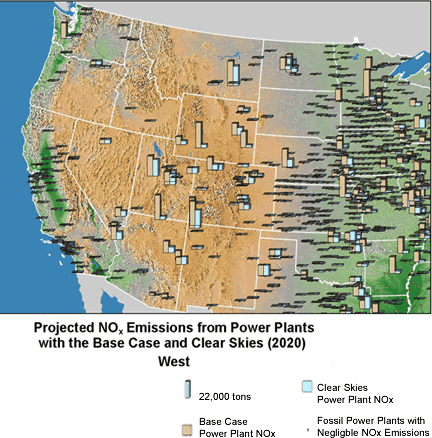
Note: The base case in IPM includes Title IV, the NOx SIP Call, NSR settlements, and state-specific caps in CT, MA, MO, NC, NH, TX, and WI. It does not include mercury MACT in 2007 or any other potential future regulations to implement the current ambient air quality standards or other parts of the Clean Air Act. Base case emissions in 2020 will likely be lower due to state and federal regulatory actions that have not yet been promulgated. Emissions projected for new units in 2020 are not reflected.
Clear Skies Health and Air Quality Benefits in Idaho
Improve Public Health
| By 2020, Idaho would receive approximately $8.6 billion in annual health benefits from reductions in fine particle and ozone concentrations alone due to Clear Skies. (see note 1) |
- Reduced ozone and fine particle exposure by 2020 would result in public health benefits of:
- approximately 1,100 fewer premature deaths each year (see note 1)
- approximately 800 fewer cases of chronic bronchitis each year
- approximately 1,800 fewer nonfatal heart attacks each year
- approximately 2,500 fewer hospital and emergency room visits each year
- approximately 150,000 fewer days workers are out sick due to respiratory symptoms each year
- approximately 19,000 fewer school absences each year
- Reduced mercury emissions would reduce exposure to mercury through consumption of contaminated fish, resulting in additional, unquantified benefits for those who eat fish from Idaho's lakes, streams, and coastal waters.
Help Maintain Health-Based Air Quality Standards (see note 2)
- All counties in Idaho are currently expected to meet the 8-hour ozone and fine particle standards.
- Clear Skies would reduce concentrations of fine particles throughout Idaho, providing additional benefits to public health.
Clear Skies Would Provide Important Environmental Benefits in the West
Clear Skies would produce significant visibility benefits in highly visited national parks and wilderness areas in the West.
- Quantifiable visibility benefits in just 5 parks (Grand Canyon, Rocky Mountain, Zion, Bryce Canyon, and Mesa Verde National Parks) total over $300 million.
- Visibility benefits in the Grand Canyon alone are estimated to be $100 million annually by 2020.
- Visibility improvements are also projected to improve tourism.
- In comparison to existing programs, nitrogen deposition would decrease by 5-20% in the intermountain West, and in some areas, such as the Four Corners region, by up to 35%. Sulfur and mercury deposition would not increase despite growth in electricity demand.
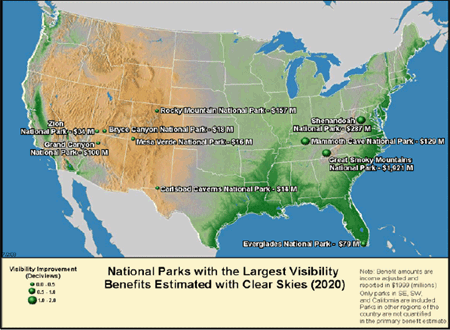
For a larger image, click here
Electricity Generation in Idaho under Clear Skies
| Current and Projected Generation by Fuel Type in Idaho under Clear Skies (GWh) | ||
 |
|
|
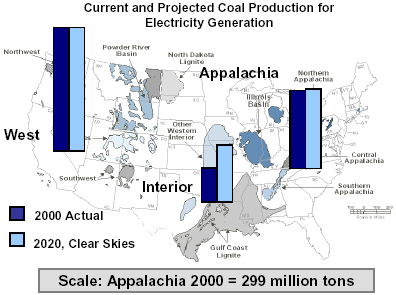
Electricity Prices in Idaho under Clear Skies
|
|
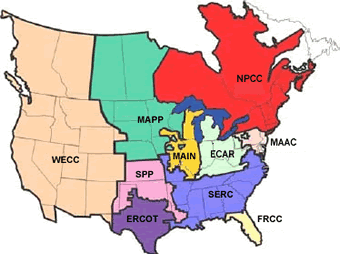 |
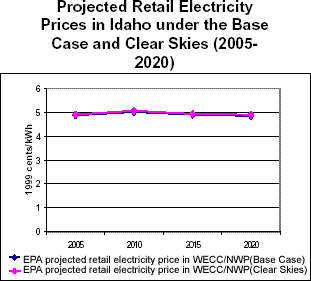
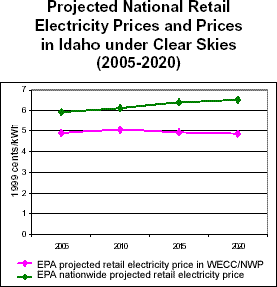
| In 2000, the average retail electricity price in Idaho was approximately 4.2 cents/kWh, which was below the average national retail price of approximately 6.7 cents/kWh. Retail prices in WECC are projected to decrease and remain below the national average between 2005 and 2020. |
Note: The base case using IPM includes Title IV, the NOx SIP Call, NSR settlements, and state-specific caps in CT, MA, MO, NC, NH, TX, and WI. It does not include mercury MACT in 2007 or any other potential future regulations to implement the current ambient air quality standards or other part of the Clean Air Act. Base case emissions in 2020 will likely be lower due to state and federal regulatory actions that have not yet been promulgated.
Costs and Benefits in Idaho under Clear Skies
Benefits Outweigh the Costs
Clear Skies....
|
- In Idaho, economic modeling projects that the cost of generating
electricity, of which a component is the cost of installing and
operating pollution controls, is less under Clear Skies than under
the base case. This is because power production shifts within
the region enable the power sector to comply in the most cost-effective
manner. Total annual health and visibility benefits in 2020 for
Idaho are projected to be $24 million, with region wide benefits
projected to be $9.5 billion annually.
- Nationwide, the projected annual costs of Clear Skies (in $1999) are $4.3 billion in 2010 and $6.3 billion in 2020; the nationwide benefits of Clear Skies are expected to be over $113 billion annually by 2020.
- An alternate estimate projects annual health
benefits totaling $23 billion.
Note: Costs include capital costs, fuel, and other operation and maintenance costs (both fixed and variable) associated with the achievement of the emissions caps in the legislation (for example, the installation and operation of pollution controls). These state-level production costs are estimates; they do not account for the costs associated with the transfer of electricity across regions, nor the costs or savings that could be associated with allowance movement between sources.
Notes on EPA's Analysis
- The information presented in this analysis reflects EPA's modeling
of the Clear Skies Act of 2003.
- EPA has updated this information to reflect modifications:
- Changes included in the Clear Skies Act of 2003.
- Revisions to the Base Case to reflect newly promulgated rules at the state and federal level since the initial analysis was undertaken.
- The Clear Skies modeling results presented include the safety valve feature
- This analysis compares new programs to a Base Case ( Existing Control Programs), which is typical when calculating costs and benefits of Agency rulemakings.
- The Base Case reflects implementation of current control programs
only:
- Does not include yet-to-be developed regulations such as those to implement the National Ambient Air Quality Standards.
- The EPA Base Case for power sector modeling includes:
- Title IV, the NOx SIP Call, NSR settlements, and state-specific caps in Connecticut, Massachusetts, Missouri, New Hampshire, North Carolina, Texas, and Wisconsin finalized before March 2003.
- For air quality modeling, the Base Case also includes federal and state control programs, as well as the Tier II, Heavy Duty Diesel, and Nonroad Diesel rules.

1. An alternative methodology for calculating health-related benefits projects approximately 600 premature deaths prevented and $1.6 billion in health benefits each year in the West by 2020.
2. Based on 1999-2001 data for counties with monitors that have three years of complete data.
|
State information based on EPA's modeling of the Clear Skies Act of 2002 is presented here for archival reasons.
|

